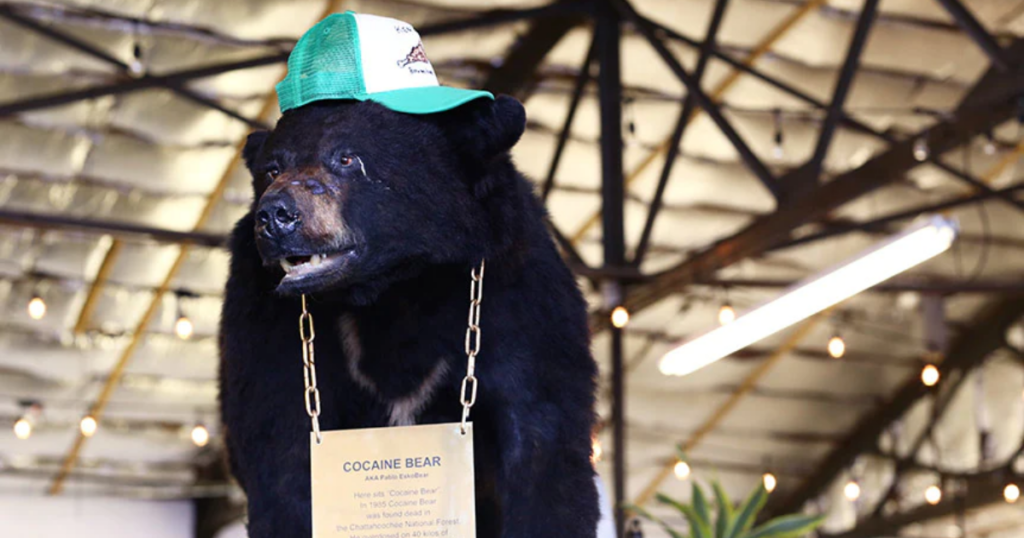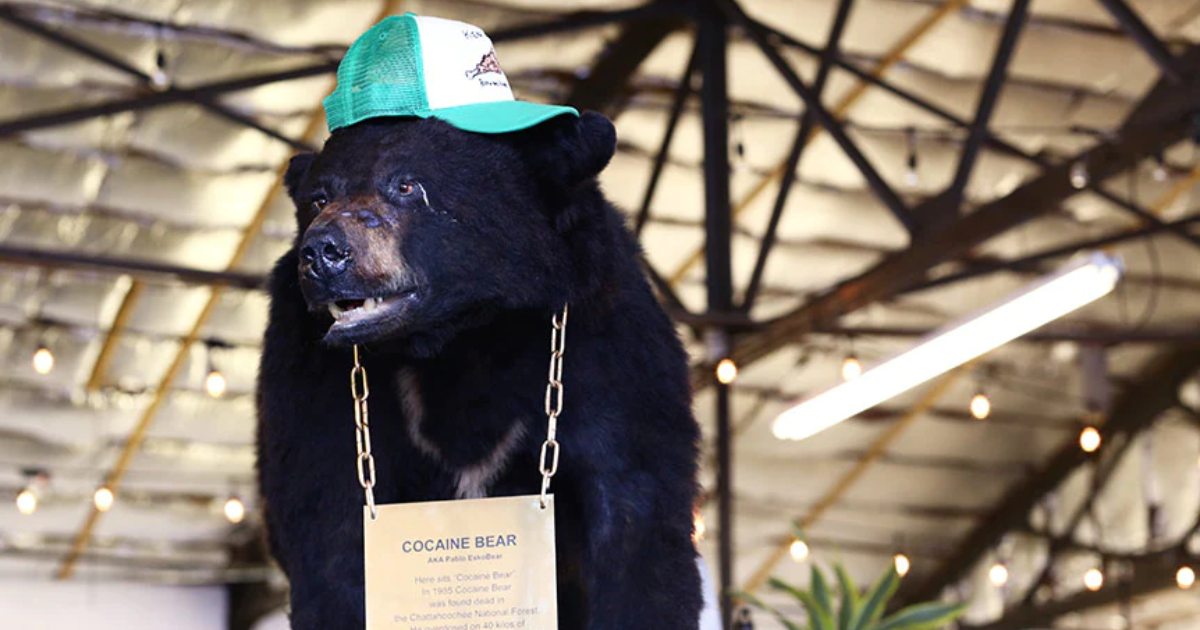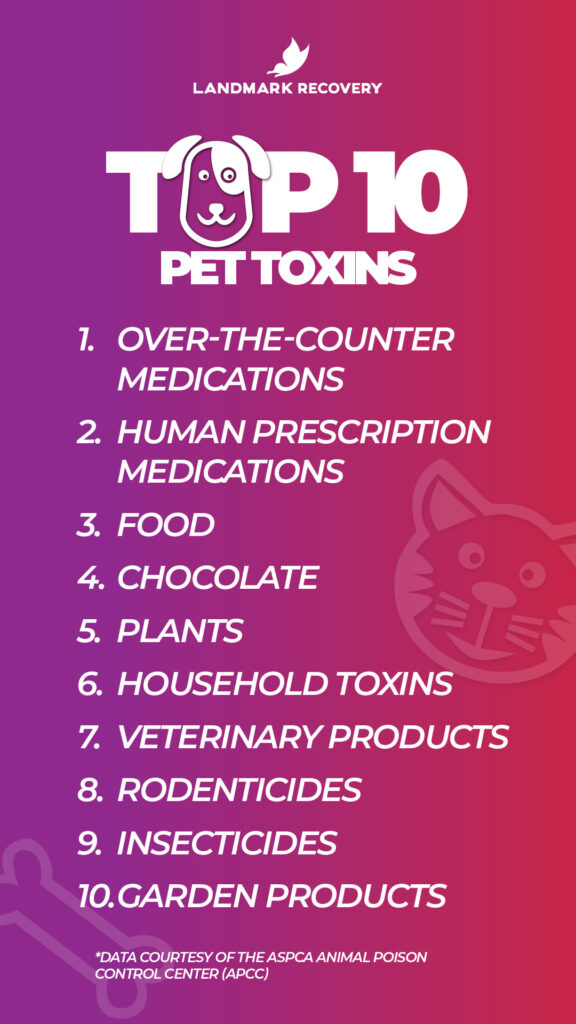Published: Feb. 22, 2023 | Updated: Feb. 23, 2023, at 11:28 a.m. (CST)
Editors note: Cocaine Bear features substance use and violence. This blog explores the dangers of exposing animals to drugs and alcohol. If you think your pet might have consumed a poisonous substance, immediately call the ASPCA Animal Poison Control Center (APCC) at 888-426-4435. The APCC handles animal poison-related emergencies 24 hours a day, 365 days a year.
The film “Cocaine Bear,” a darkly exaggerated comedy directed by Elizabeth Banks, is set to hit theaters on Friday, February 24. The movie features a star-studded cast, including Jesse Tyler Ferguson, O’Shea Jackson Jr. and the late Ray Liotta, as well as a plethora of violence, gore, bad language and drug use. The main star of “Cocaine Bear” is a 500-pound bear who consumes a large amount of cocaine and rampages in the forest.
The R-rated movie was inspired by a failed drug run near the border of Tennessee and Georgia that resulted in the deaths of a drug trafficker and a black bear in 1985.
Where can we watch “Cocaine Bear”?
As of now, “Cocaine Bear” is only available to watch in theaters on Friday, February 24. Those who prefer to stream movies will have to wait until it becomes available on platforms like Netflix, Hulu and Amazon Prime Video.
Use the following links to find showtimes at a theater near you:
Is “Cocaine Bear” based on a true story?

Andrew Thornton II’s body was found in a Knoxville resident’s driveway in 1985. (Archive Photo by the Knoxville News Sentinel)
“Cocaine Bear” is inspired by events that are even stranger than the fictional plot. In 1985, Andrew Thornton II, a former narcotics officer, lawyer and convicted drug trafficker, died in a failed drug drop in East Tennessee. According to reports, Thornton was on a cocaine-smuggling run from Colombia, piloting a plane that would drop packages off in the United States.
Worried the plane would crash and that federal agents would catch him, Thornton dumped at least 40 containers of cocaine and jumped from it. He accidentally deployed the backup parachute and suffered a fatal crash landing in Knoxville. The Knoxville News Sentinel reported that Thornton’s body was found in a driveway. He was strapped to cocaine worth about $15 million, and was also carrying a key to the plane, which crashed in the mountains of North Carolina. But that’s not where the story ends.
What happened to the real “Cocaine Bear?”
The movie features a 500-pound bear that, after consuming cocaine, goes on a murderous rampage. What really happened was that months after Thornton’s crash landing in 1985, a 175-pound black bear was found dead in the Chattahoochee National Forest in northern Georgia. Located near the bear were empty containers of cocaine later connected to the plane Thornton piloted.
Officials believed the bear had torn open the containers and consumed over 70 pounds of cocaine worth nearly $15 million. A medical examiner confirmed that the bear suffered a fatal drug overdose.
“Its stomach was literally packed to the brim with cocaine. There isn’t a mammal on the planet that could survive that,” said a medical examiner who performed the bear’s necropsy in a statement via The Independent. “Cerebral hemorrhaging, respiratory failure, hyperthermia, renal failure, heart failure, stroke. You name it, that bear had it.”
The bear was taxidermied (stuffed) and eventually put on display at Kentucky For Kentucky Fun Mall in Lexington, Ky. The shop obtained the stuffed bear in 2015.

The real “Cocaine Bear” has been on display at the Kentucky for Kentucky Fun Mall since 2015 (Photo by the Kentucky for Kentucky Fun Mall)
“For a long time no one cared about this bear, and he got passed along from hand to hand, and we got a hold of him back in 2015 and just really have taken ahold of his whole crazy past and his whole crazy background,” Anne Livengood, sales and marketing director at Kentucky for Kentucky Fun Mall, told Inside Edition Digital. “It’s become a big part of the Kentucky culture and a big part of people come from all over the world to visit him.”
Can animals really get intoxicated?
“Cocaine Bear” illustrates just how possible it is for animals to become under the influence of drugs and alcohol. Animal research suggests that intoxication is circumstantial. Some wild animals live off natural foods containing alcohol and other mind-altering drugs, and can end up stoned, high or drunk. Interestingly enough, other species might search for the substances found in natural foods like plants in order to achieve a high.
Like humans, size usually determines how intoxicated animals can become. The smaller the animal, the more likely they are to get impaired when eating fermented fruit containing alcohol, for example. Larger animals like black bears, however, may have a higher tolerance for substances, become only slightly “tipsy” or not show any signs of intoxication.
Let’s look at a few examples.
Pen-tailed tree shrews live off alcoholic fruit
The pen-tailed tree shrew, a small mammal native to Southeast Asia, is known for having a high alcohol tolerance despite only growing between 5-9 inches long. Tree shrews live off Bertam palm nectar, which has one of the highest alcohol concentrations found in natural foods. In 2008, Frank Wiens and a team of researchers from the University of Bayreuth in Germany found the nectar to have an alcohol level of 3.8% abv, the same as Michelob Ultra Pure Gold Beer. However, the treeshrews showed no signs of being drunk.
Wiens and his team observed that the tree shrews ate the nectar longer than any other food source, for an average of 138 minutes each night. The team calculated that once every three days, tree shrews eat enough nectar to become as intoxicated as a woman who drinks nine glasses of wine or beer in a 12-hour period.
Birds use ants as stimulant drugs
Some animal research suggests that birds use ants as a stimulant. The behavior is known as “anting.” Birds sit on top of anthills or trees, grab formicine ants with their beaks and wipe them on their wings. The ants release formic acid, a spray meant to protect them from predators. Many birds remain unharmed by the acid.
“One explanation for this is that birds use the ants’ formic acid as a stimulant, much like people smoking or taking drugs,” Ornithologist Stefan Emanuel Baltag told Vice in 2015.
Moose and fermented fruit
Moose have a taste for fermented (rotted fruit) and have been spotted many times appearing under the influence. In 2007, Alaskan shoppers noticed a large moose wandering around downtown Anchorage, tangled in Christmas lights. Fish and Game biologist Rick Sinnott suspected the moose had eaten too many fermented crab apples from a tree.
“He just has this goofy look on his face,” said Sinnott, who examined the moose. “He’s either drunk or in gastric distress.”
Although moose might appear drunk, it would take a lot more than fermented apples to get them intoxicated, due to their large size. Moose can weigh up to 1,200 pounds, which wild animal experts say is too much to get drunk on fermented fruit. Moose also eat up to 70 pounds of food daily to maintain their weight. The more likely explanation is that their digestive systems can’t handle massive amounts of sugary fruits like fermented apples.
How drugs and alcohol affect pet animals
Unlike black bears, moose and pen-tailed tree shrews, domestic animals like cats and dogs are more prone to the harmful effects of drugs and alcohol. Pets are generally curious, and can often find themselves drawn to the same tasty foods that humans eat. Therefore, it’s common for a pet dog, cat or even bird to get tipsy without their owners noticing.
Pet poisoning
Leaving out a half-drunk beer can or a glass of wine could result in alcohol poisoning if a pet drinks it. This can result in depression in their central nervous systems. The animal could become drowsy and uncoordinated, lose consciousness and potentially die.
Pet poisoning isn’t limited to just alcohol. Dogs and cats could also be attracted to foods that contain other intoxicating substances. Maybe they ate the rum cake you made, an unbaked yeast dough or “edibles” containing cannabis (marijuana), like chocolate chip cookies or brownies.
The point is, many substances are toxic for domestic animals. There are thousands of calls made each year on behalf of pets exposed to dangerous substances. In 2022, the ASPCA Animal Poison Control Center (APCC) released the top 10 most common toxins responsible for sickening pets, after receiving calls about over 320,000 items that pets were exposed to.
The top 10 included:
- Over-the-counter (OTC) medications
- Human prescription medications
- Food
- Chocolate
- Plants
- Household toxins
- Veterinary products
- Rodenticides
- Insecticides
- Garden products
Over-the-counter (OTC) medications
According to the ASPCA, over-the-counter (OTC) medications were the top toxin on its list for the fourth year in a row, making up more than 17% of the APCC’s call volume. This includes ibuprofen, vitamin D and herbal supplements.
Human prescription medications
Human prescription medications, the second top toxin on the list, included antidepressants, and cardiac and ADHD medications. If pets consume them, they could experience gastrointestinal upset and kidney failure in severe cases.
Human food
The third top toxin was human food products, which accounted for 14% of APCC cases in 2021. The most common food product cases included the consumption of protein bars and shakes, xylitol, garlic, onions, grapes and raisins.
Chocolate
The APCC says it averages over 103 daily cases of chocolate consumption among pet animals, which results in more than one case every 15 minutes. Chocolate is a common food that marijuana (cannabis; THC) is mixed into (edibles). According to a 2016 Colorado study published in the Canadian Veterinary Journal, two dogs died after they ate baked goods that included butter with concentrated medical-grade tetrahydrocannabinol (THC).
The fact that these four products were among the top pet toxins demonstrates how common it is for them to get into everyday items humans often consume. Dogs and cats are smaller in size compared to humans, which means they can quickly consume a toxic dose of a drug or alcohol. If it’s an edible or opioid pain pill that produces strong effects for humans, imagine how toxic it could be for a pet.
However, it’s not only what animals eat or drink that could cause problems if their owners engage in substance use.
Pet owners and substance use
When pet owners use drugs and alcohol, they can often forget their responsibilities and leave their pets hanging. They might forget to take their pets for a walk or give them bad food. As a result, pets are often affected by this behavior in the following ways:
- Mental distress
- Neglect
- Abuse
@landmarkrecovery Every stage is worth it 💕 #landmarkrecovery #petsmart #addictionrecovery #addiction #sobriety #dogsoftiktok #sober #doglover #fyp #sobertiktok
Pets can sense when something is wrong
According to a 2012 report from PBS, the part of a dog’s brain that is devoted to analyzing smells is, proportionally speaking, 40 times greater than ours. They have a better sense of smell than humans and can smell alcohol on their owner’s breath or coming from their pores.
Pets might also respond to body language. If a person is drunk or high, they might act and move differently, Rover.com writes. A loss of coordination might cause them to bump into furniture or stumble around the house in the middle of the night, which might also concern their pet animal.
Reccommended: 5 Ways to Care For Your Pet During Drug Rehab
Impact of drug addiction on animals
It’s important to know that humans aren’t the only individuals impacted by drugs and alcohol. Whether it’s a wild black bear or a house dog, it’s possible for animals to suffer from the harmful effects of substance use. Many people struggling with addiction neglect their pets.
They may forget to feed them, or decide it’s more important to get drunk or high than take their dog for a walk. Regardless of recreational drug use or active addiction, knowing what animals may go through when exposed to drugs or alcohol should be enough to make pet owners more cautious or get help.
If you or someone you know struggles with drugs or alcohol, call 888-448-0302 for more information.

Choose Recovery Over Addiction
We're here 24/7 to help you get the care you need to live life on your terms, without drugs or alcohol. Talk to our recovery specialists today and learn about our integrated treatment programs.






